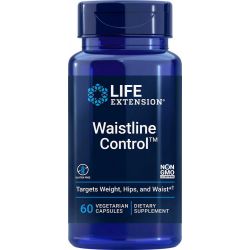Critical Need For a Multi-Modal Approach to Combat Obesity part 2
Impeding Carbohydrate Absorption
 Blocking the breakdown and absorption of carbohydrates are important points of intervention for losing weight. The objective is to target specific enzymes in the intestine, before calorie-rich carbo-hydrates enter the circulation.
Blocking the breakdown and absorption of carbohydrates are important points of intervention for losing weight. The objective is to target specific enzymes in the intestine, before calorie-rich carbo-hydrates enter the circulation.
Researchers at the innovative Integrative Medicine Program at the UCLA School of Medicine have been actively exploring this area, using extracts from the common white kidney bean (Phaseolus vulgaris).21 The bean extract attains its effect by blocking the alpha-amylase starch-digesting enzymes in the intestine.22 In order to validate this theory, a study was done where 27 obese adults took either a placebo or the Phaseolus vulgaris extract known to "neutralize" the amylase enzyme.21 After eight weeks, those taking the white bean extract lost 3.8 pounds in weight, and 1.5 inches of abdominal fat. Other important benefits were observed in those taking the Phaseolus vulgaris such as a three-fold reduction in triglyceride levels compared with the placebo recipients. Suppressing blood triglyceride levels is often an important component of a long-term weight-loss program.
In another human study of Phaseolus vulgaris,23 researchers discovered that those who consumed the most carbohydrates lost the most weight. Those study subjects consuming the highest levels of dietary starch and supplemented with Phaseolus vulgaris lost 8.7 pounds compared with only 1.7 pounds in the control group. Even more impressive was the 3.3 inches of belly fat lost in the Phaseolus vulgaris group versus only 1.3 inches in the controls. The conclusions showed that weight loss is attainable with diet modification, exercise, and behavioral interventions and it can be enhanced in people with high starch intakes through the addition of Phaseolus vulgaris to impede absorption of carbohydrate calories.
In a remarkable double-blind study on 60 overweight volunteers, half the study participants received 445 mg a day of Phaseolus vulgaris while the other half were given a placebo.24 Both groups were placed on a 2,000-2,200/day-calorie, carbohydrate-rich diet. After only 30 days, those taking Phaseolus vulgaris lost 6.5 pounds of weight and 1.2 inches in waist size compared with 0.8 pounds and 0.2 inches in the placebo group.
These kinds of studies show the futility of trying to lose weight by restricting caloric intake alone, yet demonstrate remarkable effects when just one natural weight loss compound is combined with reductions in food intake.
Impeding the Alpha-Glucosidase Enzyme
 While inhibiting intestinal amylase enzyme activity has demonstrated some fat-loss results, it may be equally important to impede another enzyme needed for carbohydrate absorption called alpha-glucosidase.
While inhibiting intestinal amylase enzyme activity has demonstrated some fat-loss results, it may be equally important to impede another enzyme needed for carbohydrate absorption called alpha-glucosidase.
European researchers working with extracts of several seaweed species found that extracts of the Fucus vesiculosus (bladder wrack) caused significant reductions in blood glucose eight hours after being given to rabbits.25 Subsequent research has uncovered a host of health benefits from seaweed extracts, including powerful antioxidant, anti-tumor, and vascular health-promoting effects.26-29
Intrigued by these findings, researchers began exploring the antidiabetic properties of various seaweeds, including bladder wrack and Ascophyllum nodosum, also known as brown algae. What they discovered was that these seaweeds were capable of strongly inhibiting the carbohydrate-digesting alpha-glucosidase enzyme in rat intestines.28 Given to diabetic rats in the laboratory, the extracts reduced fasting glucose levels significantly at 14 days and blunted the sharp rise in blood glucose (postprandial effect) following an oral glucose tolerance test. Interestingly, the animals also experienced decreases in total cholesterol and sugar-damaged (glycated) protein levels.
A proprietary combination of extracts from bladder wrack and brown seaweed known as InSea2™, has been shown to help modulate dangerous postprandial sugar swings that lead to increased protein (glycation) damage, abdominal obesity, and food cravings that often come after a meal rich in carbohydrates.30-32 While these results have not yet been published, they reveal important aspects of how these extracts may work to improve metabolic health, a critical component of achieving normal weight.
 The formulator of InSea2™ first conducted a series of studies to demonstrate the effect of the extracts on inhibiting the digestive enzymes, amylase and glucosidase. Both enzymes were powerfully inhibited within a few minutes of being exposed to the seaweed extracts. Additionally, they found that when InSea2™ was fed to laboratory animals, glucose levels were reduced by up to 90% following a meal compared with non-supplemented animals. Insulin levels (a measure of insulin sensitivity) were as much as 40% lower in the InSea2™-supplemented rats.33 Clearly, this supplement may provide important benefits in reducing metabolic parameters that impact both systemic health issues as well as weight gain.
The formulator of InSea2™ first conducted a series of studies to demonstrate the effect of the extracts on inhibiting the digestive enzymes, amylase and glucosidase. Both enzymes were powerfully inhibited within a few minutes of being exposed to the seaweed extracts. Additionally, they found that when InSea2™ was fed to laboratory animals, glucose levels were reduced by up to 90% following a meal compared with non-supplemented animals. Insulin levels (a measure of insulin sensitivity) were as much as 40% lower in the InSea2™-supplemented rats.33 Clearly, this supplement may provide important benefits in reducing metabolic parameters that impact both systemic health issues as well as weight gain.
Upon further review of the study data, scientists found another interesting effect in the group supplemented with InSea2™. The normal response to an after-meal spike in blood glucose is a surge in insulin secretion. This insulin surge often causes blood glucose to be driven down too low. This can then create artificial hunger for more calories to elevate the depressed glucose blood levels. In lab animals taking InSea2™, the dramatic post-meal drop in glucose levels did not occur, and their glucose levels returned to baseline levels in a more gradual and natural fashion.
The after-meal drop in blood sugar produces a feeling of fatigue and can foster a sense of increased hunger leading to additional caloric intake. By "smoothing out" the postprandial sugar drop, InSea2™ exerts both biochemical and behavioral benefits on overall calorie intake. In the researchers' words, "InSea2™ was able to change the absorption profile of a high-glycemic index (GI) food towards that of a low-GI food."33
The Multiple Biological Effects of Irvingia Gabonensis
Irvingia gabonensis has been used in food preparation for millennia in Africa, where it is prized for its nutritional potential.34,35 Based on its known therapeutic properties, scientists began to examine Irvingia extracts for their ability to achieve glucose control.36 The researchers found that Irvingia supplements produced a reduction in plasma lipid levels, especially the dangerous very low-density lipoprotein (VLDL), LDL, and triglycerides.37 The team went on to study Irvingia's effect in rats, seeking to understand the molecular reasons for these impressive results.38 What they found was that Irvingia produced a marked reduction in levels of a host of amylase enzymes, culminating in reduced absorption of glucose and concomitantly lower levels in blood and urine.
 While Irvingia research continued to focus on its antioxidant and antimicrobial effects,39-42 scientists began exploring its potential for combating obesity. The results of these investigations on weight loss and lipid control were eventually published.43 In the first study, 28 people received the Irvingia supplement and 12 were given a placebo. All subjects stayed with their regular diets. After the month-long study period, the Irvingia group had lost 5.26% of their body weight, whereas placebo recipients shed only 1.32%. As in the older studies, supplemented patients, but not placebo patients, experienced decreases in total cholesterol, LDL, and triglycerides and an increase in HDL.
While Irvingia research continued to focus on its antioxidant and antimicrobial effects,39-42 scientists began exploring its potential for combating obesity. The results of these investigations on weight loss and lipid control were eventually published.43 In the first study, 28 people received the Irvingia supplement and 12 were given a placebo. All subjects stayed with their regular diets. After the month-long study period, the Irvingia group had lost 5.26% of their body weight, whereas placebo recipients shed only 1.32%. As in the older studies, supplemented patients, but not placebo patients, experienced decreases in total cholesterol, LDL, and triglycerides and an increase in HDL.
Stimulated by these findings of Irvingia in human trials, researchers set out to discover exactly how these effects were being obtained. They did this armed with new knowledge about the complex interactions of fat tissue in the metabolic processes, including its influence by, and on, various biochemicals involved in inflammation.44 The researchers focused on three key elements: 1) a substance called PPAR gamma, produced by a gene known to contribute to human obesity; 2) the hormone leptin (which suppresses appetite and increases triglyceride breakdown in adipocytes); and 3) adiponectin (which reduces fat deposition).
Using fat cells from mice, the researchers examined the effects of Irvingia extract on these three important players in the obesity-generating process. After just eight days of treatment, the cells were found to have significantly reduced their production of fat stores. This result occurred in response to the inhibition of an enzyme (glycerol-3-phosphate dehydrogenase) responsible for converting glucose to stored triglyceride in adipocytes. This was accompanied by a decrease in expression of PPAR gamma, with a corresponding increase in the production of the insulin-sensitizing compound adiponectin. These were compelling results âas the researchers concluded that, "[Irvingia] may play an important multifaceted role in the control of adipogenesis [fat production] and have further implications in in-vivo anti-obesity effects."44
Encouraged by these findings, the researchers progressed to larger human studies. In a recently published study in the journal Lipids in Health and Disease,45 human subjects who supplemented with Irvingia enjoyed significant improvements in body weight, body fat, and waist circumference, while their plasma lipid, adiponectin, and leptin levels were all improved. Interestingly, supplemented subjects also experienced decreases in levels of the inflammatory marker C-reactive protein, which is a known cardiovascular risk factor.46 Reduction of inflammation is now gaining the attention of scientists around the world as another important component for controlling weight and metabolic disorders. The authors' conclusion is "Irvingia gabonensis extract may prove to be a useful tool in dealing with the emerging global epidemics of obesity, hyperlipidemia, insulin resistance, and their co-morbid conditions."45
Perhaps one of the most consistent benefits of Irvingia supplementation was a reduction in appetite among study subjects. Avoiding over-consumption of calories remains a critical aspect of a science-based weight-loss program.
Summary
Scientists now recognize many biochemical pathways and control mechanisms that help regulate how we absorb, distribute, and expend ingested food throughout the body. With each new discovery we identify additional points for intervention that can tip the scales in favor of successful reductions in body fat.
Natural supplements whose mechanisms of action are clearly understood are available to help in controlling body weight. Used responsibly and in combination, these nutrients may complement one another and have the potential to yield maximum control over abdomfdrhginal fat, obesity, and cardiovascular health.
Advances in our understanding of the causes of obesity are paying off on multiple fronts. While the nutrients described in this article provide many components of a multi-modal weight-loss program, we encourage members to carefully review all the articles in this month's issue to fully take advantage of today's wealth of knowledge about shedding excess fat pounds.
Material used with permission of Life Extension. All rights reserved.
1. Curr Atheroscler Rep. 2002 Nov;4(6):448-53.
2. Eur J Clin Nutr. 2006 Jan;60(1):18-24.
3. Drug Metab Dispos. 2003 May;31(5):572-9.
4. Biochem Pharmacol. 2005 May 15;69(10):1523-31.
5. Am J Physiol Regul Integr Comp Physiol . 2007 Jan;292(1):R77-R85.
6. Int J Obes Relat Metab Disord. 2000 Feb;24(2):252-8.
7. J Nutr. 2009 Feb;139(2):264-70.
8. Integr Nutr. 2008;11(2):1-14.
9. J Vet Pharmacol Ther. 2007 Apr;30(2):132-8.
10. Biochem Mol Biol Int. 1998 Dec;46(5):895-903.
11. Pharmazie. 2008 Jan;63(1):35-42.
12. J Nutr Biochem. 2000 Jan;11(1):45-51.
13. J Agric Food Chem. 2005 Jun 1;53(11):4593-8.
14. J Nutr Biochem. 2007 Mar;18(3):179-83.
15. J Nutr. 2008 Sep;138(9):1677-83.
16. Pflugers Arch. 2008 Nov;457(2):293-302.
17. Phytother Res. 2008 Dec 23.
18. Mol Nutr Food Res. 2009 Mar;53(3):349-60.
19. J Am Coll Nutr. 2007 Aug;26(4):389S-95S.
20. Phytochemistry. 2009 Jan;70(1):11-24.
21. Altern Med Rev. 2004 Mar;9(1):63-9.
22. Yao Xue Xue Bao. 2007 Dec;42(12):1282-7.
23. Altern Ther Health Med. 2007 Jul;13(4):32-7.
24. Int J Med Sci. 2007;4:45-52.
25. J Ethnopharmacol. 1989 Nov;27(1-2):35-43.
26. Eur J Cell Biol. 1997 Dec;74(4):376-84.
27. J Agric Food Chem. 2002 Feb 13;50(4):840-5.
28. Can J Physiol Phar macol. 2007 Nov;85(11):1116-23.
29. Anticancer Res. 1996 May-Jun;16(3A):1213-8.
30. Am J Clin Nutr. Dec 2006;84(6):1365-73.
31. Clin Dermatol. 2004 Jul;22(4):310-4.
32. Arch Intern Med. 2006 Jul 24;166(14):1466-75.
33. http://www.innovactiv.com/index.php?option=com_contentandamp;task=viewandamp;id=18andamp;Itemid=
34. Council NR. “Dika”. Lost Crops of Africa. Vol II: Vegetables: National Academies Press; 2006:119.
35. J Ethnopharmacol. 1995 Feb;45(2):125-9.
36. Enzyme. 1986;36(3):212-5.
37. West Afr J Med. 1990 Apr;9(2):108-15.
38. Ann Nutr Metab. 1993;37(1):14-23.
39. J Agric Food Chem. 2005 Aug 24;53(17):6819-24.
40. Mol Ecol. 2000 Jul;9(7):831-41.
41. J Agric Food Chem. 2002 Mar 13;50(6):1478-82.
42. Nahrung. 2004 Apr;48(2):85-7.
43. Lipids Health Dis. 2005 May 25;4:12.
44. Lipids Health Dis. 2008 Nov 13;7:44.
45. Lipids Health Dis. 2009 Mar 2;8:7.
46. Clin Chem. 2009 Feb;55(2):239-55.
47. J Nutr. 1996 Jun;126(6):1688-95.
48. Phytomedicine. 2002 Jan;9(1):3-8.
49. Asia Pac J Clin Nutr. 2008;17(Suppl 1):273-4.
50. Curr Diab Rep. 2007 Oct;7(5):333-9.
51. Metabolism. 2006 Sep;55(9):1263-81.
52. Gastroenterology. 1986 Jul;91(1):41-8.
53. Br J Nutr. 2008 Jul;100(1):1-12.


